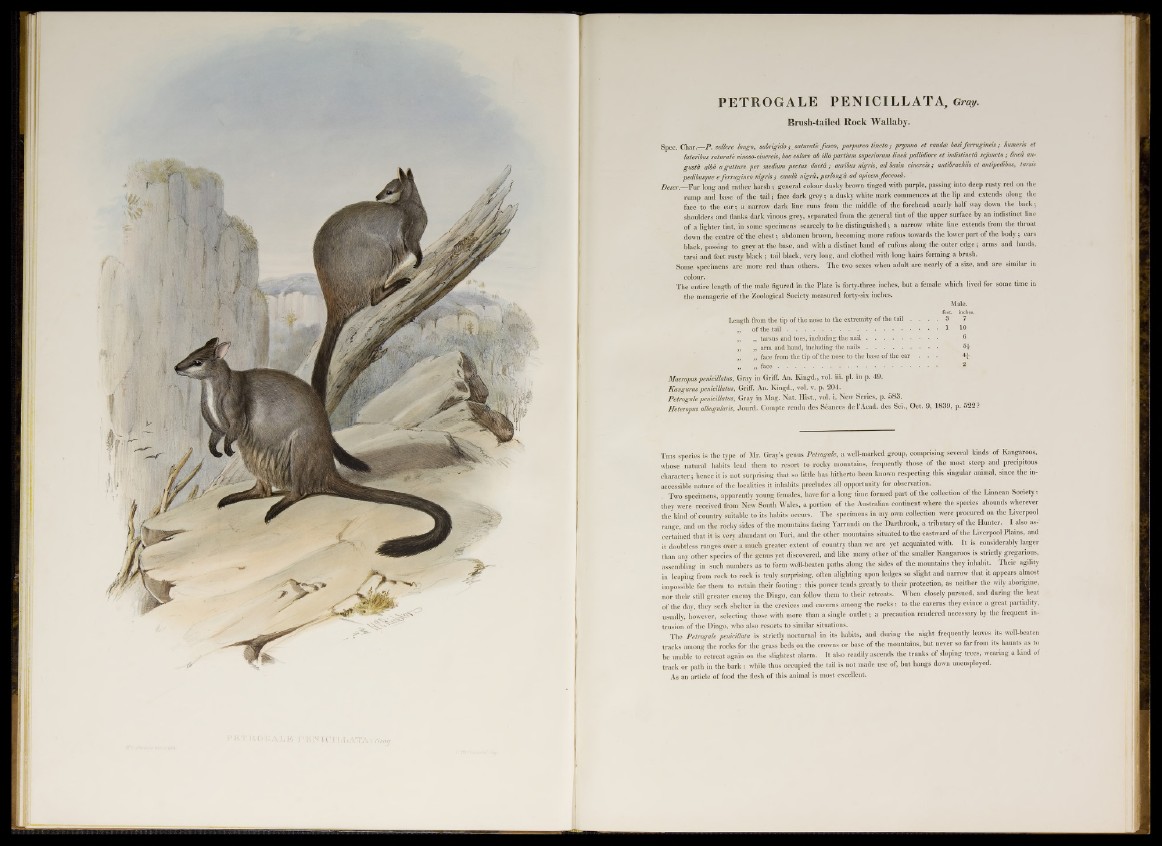
PETROGALE PENICILLATA, Gray.
Brush-tailed Rock Wallaby.
Spec. Char. P . tellere longo, subrigido ,• _saturate fusco, purpureo tincto ; prymno et caudee basiferrugineis ; humeris el
lateribus saturate oinoso-cinereis, hoc colore ab illo partium superiorum linea pallidiore et indistincta sejuncto ; linea an-
gusta alba a gutture per medium pectus ducta ; auribus nigris, ad basin cinereis; antibrachiis et antipedibus, tarsis
pedibusque eferrugineo nigris } cauda nigra, perlonga ad apicemjloccosa.
Descr. Fur long and rather harsh ; general colour dusky brown tinged with purple, passing into deep rusty red on the
rump and base o f the ta il; face dark grey; a dusky white mark commences at the lip and extends along the
face to the ear; a narrow dark line runs from the middle o f the forehead nearly half way down the back;
shoulders and flanks dark vinous grey, separated from the general tint o f the upper surface by an indistinct line
o f a lighter tint, in some specimens scarcely to be distinguished; a narrow white line extends from the throat
down the centre o f the chest; abdomen brown, becoming more rufous towards the lower part o f the body; ears
black, passing to grey at the base, and with a distinct band o f rufous along the outer ed g e ; arms and hands,
tarsi and feet rusty black ; tail black, very long, and clothed with long hairs forming a brush.
Some specimens are more red than others. The two sexes when adult are nearly o f a size, and are similar in
colour.
The entire length o f the male figured in the Plate is forty-three inches, but a female which lived for some time in
the menagerie of the Zoological Society measured forty-six inches.
Male.
feet, inches.
Length from the tip o f the nose to the extremity o f the tail . . . . 3 7
„ o f the t a i l ........................................................................................................ 1
„ „ tarsus and toes, including the n a i l .............................. 6
„ „ arm and hand, including the n a i l s ...............................................
„ „ face from the tip o f the nose to the base o f the ear . . . H
„ f a c e ........................................................................................ 2
Macropus penicillatus, Gray in Griff. An. Kingd., vol. iii. pi. in p. 49.
Kangurus penicillatus, Griff. An. Kingd., vol. v. p. 204.
Petrogale penicillatus, Gray in Mag. Nat. Hist., vol. i. New Series, p. 583.
Heteropus albogularis, Jourd. Compte rendu des Seances de l’Acad. des Sci., Oct. 9, 1839, p. 522 ?
T his species is the type of Mr. Gray’s genus Petrogale, a well-marked group, comprising several kinds of Kangaroos,
whose natural habits lead them to resort to rocky mountains, frequently those o f the most steep and precipitous
character; hence it is not surprising that so little has hitherto been known respecting this singular animal, since the inaccessible
nature o f the localities it inhabits precludes all opportunity for observation.
Two specimens, apparently young females, have for a long time formed part o f the collection o f the Linnean Society:
they were received from New South Wales, a portion o f the Australian continent where the species abounds wherever
the kind o f country suitable to its habits occurs. The specimens in my own collection were procured on the Liverpool
range, and on the rocky sides o f the mountains facing Yarrundi on the Dartbrook, a tributary o f the Hunter. I also ascertained
that it is very abundant on Turi, and the other mountains situated to the eastward o f the Liverpool Plains, and
it doubtless ranges over a much greater extent o f country than we are yet acquainted with. It is considerably larger
than any other species o f the genus yet discovered, and like many other o f the smaller Kangaroos is strictly gregarious,
assembling in such numbers as to form well-beaten paths along the sides o f the mountains they inhabit. Their agility
in leaping from rock to rock is truly surprising, often alighting upon ledges so slight and narrow that it appears almost
impossible for them to retain their footing: this power tends greatly to their protection, as neither the wily aborigine,
nor their still greater enemy the Dingo, can follow them to their retreats. When closely pursued, and during the heat
of the day, they seek shelter in the crevices and caverns among the rocks: to the caverns they evince a great partiality,
usually, however, selecting those with more than a single outlet; a precaution rendered necessary by the frequent in-
trusion o f the Dingo, who also resorts to similar situations.
The Petrogale pemdllata is strictly nocturnal in its habits, and during the night frequently leaves its well-beaten
tracks among the rocks for the grass beds on the crowns or base o f the mountains, but never so far from its haunts as to
be unable to retreat again on the slightest alarm. It also readily ascends the trunks of sloping trees, wearing a kind of
track or path in the bark : while thus occupied the toil is not made use of, but hangs down unemployed.
As an article o f food the flesh o f this animal is most excellent.